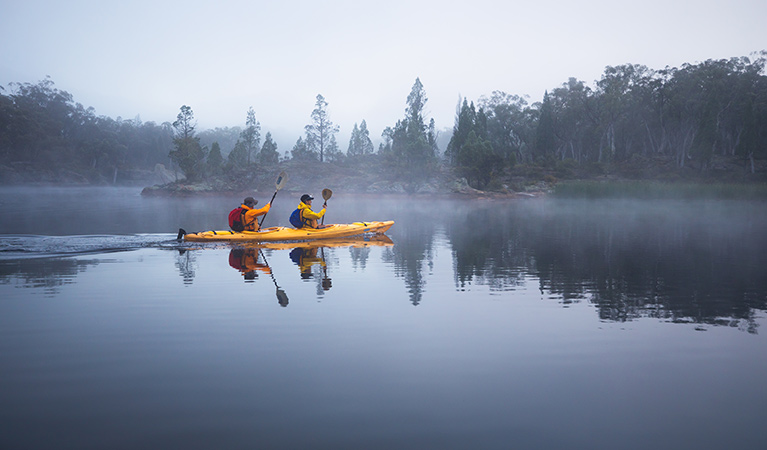Wollemi National Park
Overview
World Heritage-listed Wollemi National Park offers a dramatic setting for scenic walks, drives, wildlife spotting, glow worms, canoeing and camping, just a few hours north-west of Sydney.
Read more about Wollemi National Park
Immerse yourself in the beauty of the largest declared Wilderness Area in NSW, the Wollemi Wilderness. Part of the Greater Blue Mountains Area World Heritage Property, the park's towering cliffs, wild rivers, canyons, and serene forests spoil you with outdoor adventures.
Near Windsor, the beautiful Colo River and its picturesque gorges are stunning surrounds for hiking, picnics, riverside camping and canoeing.
Beyond the Blue Mountains, base yourself at Lithgow to explore the magical Glow Worm Tunnel, a favourite with families. The magnificent escarpments and lush gorges offer thrilling hikes and rock climbing opportunities. Stay in the Wolgan Valley or at Newnes for an adventure among the historic ruins of an oil shale mine that are slowly being reclaimed by nature on Newnes Industrial Ruins walk.
Closer to Mudgee, Gunguddy (Dunns Swamp) is a tranquil escape to set up camp, swim and take a guided canoe or kayak tour. Marvel at the remarkable alien landscape of pagoda rock formations from Pagoda lookout walking track.
The north-east of the park, on the edge of the Upper Hunter Valley, is best experienced on a scenic drive or 4WD adventure. You'll find remote camping near Sheepskin Hut, and historic remnants from the area's mining and pastoral days.
Local alerts
For the latest updates on fires, closures and other alerts in this area, see https://uat.nswparks.cloud/visit-a-park/parks/wollemi-national-park/local-alerts
Map
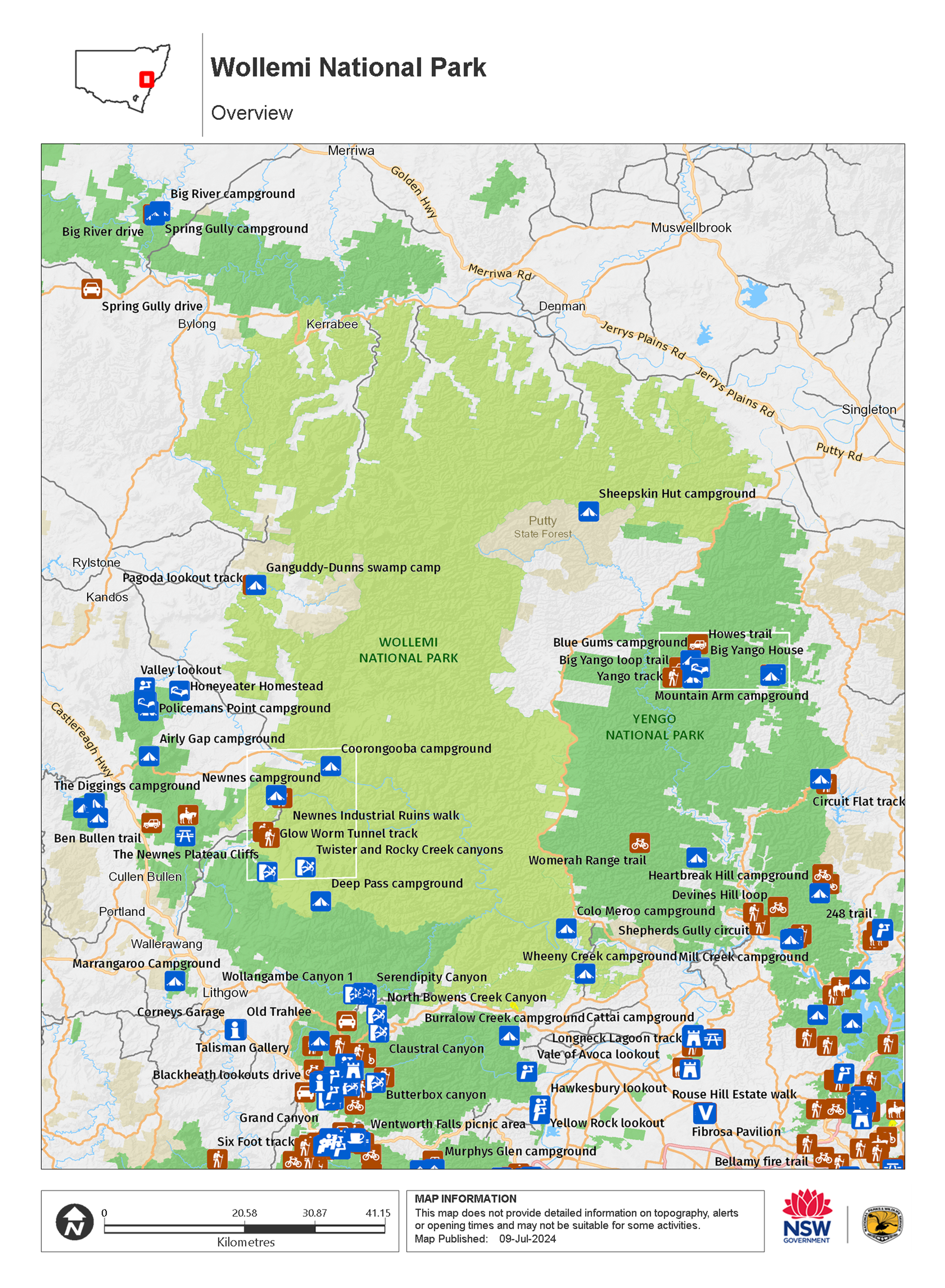
Map
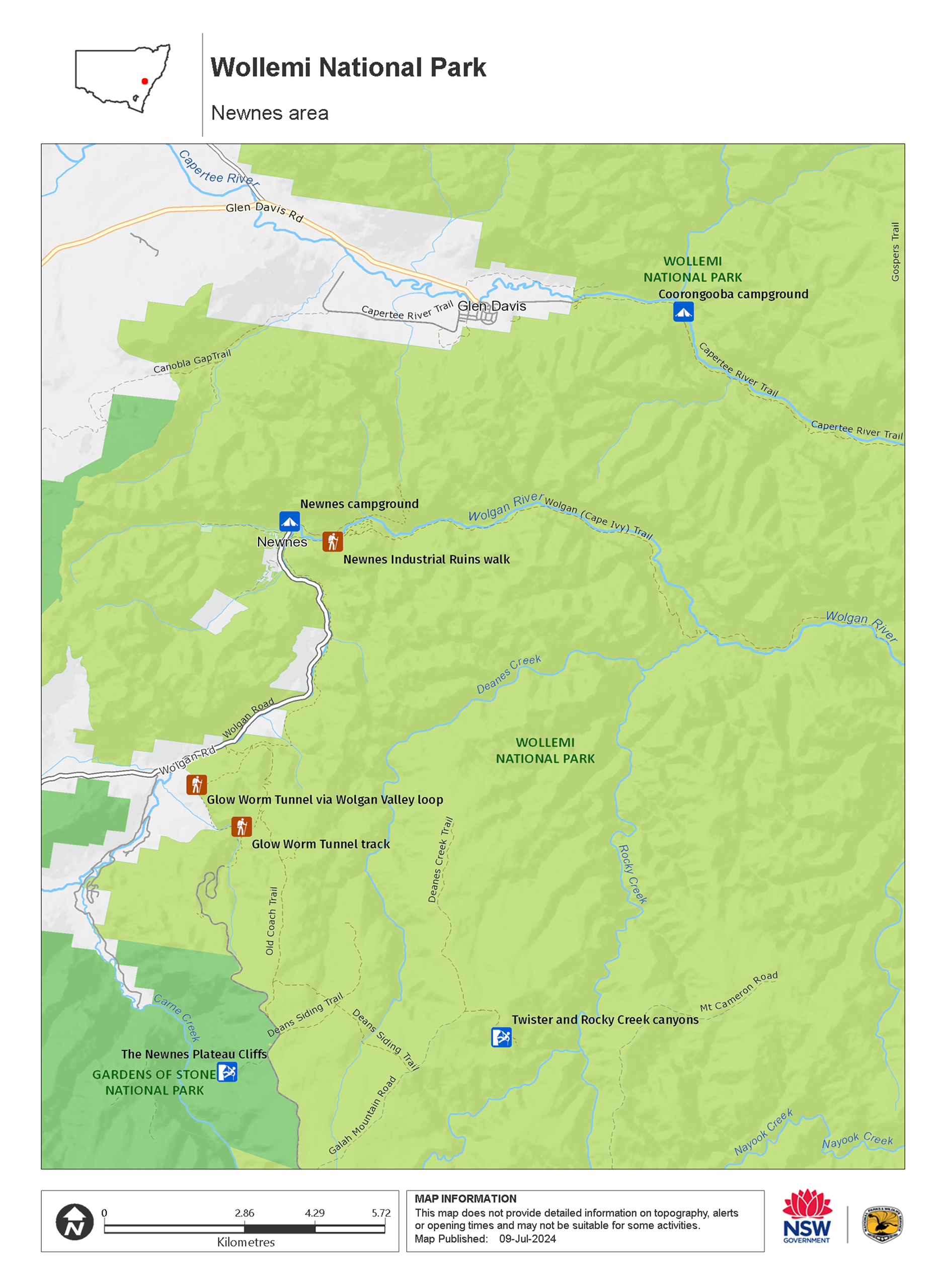
Map legend

Contact
- in the Sydney and surrounds, North Coast and Country NSW regions
Wollemi National Park is always open but may have to close at times due to poor weather or fire danger.
-
-
Blue Mountains Heritage Centre and Blackheath office
02 4787 8877
Contact hours: 9am to 4.30pm daily. Closed Christmas Day. - 270 Govetts Leap Road, Blackheath NSW 2785
-
Email: bluemountains.heritagecentre@environment.nsw.gov.au
-
Blue Mountains Heritage Centre and Blackheath office
-
-
Mudgee office
02 6370 9000
Contact hours: Monday to Friday, 9am to 4:30pm. - 27 Inglis Street, Mudgee NSW 2850
-
Email: npws.mudgee@environment.nsw.gov.au
-
Mudgee office
-
-
Bulga office
02 6574 5555
Contact hours: Monday to Friday, 9.30am to 4pm. - 2156 Putty Road, Bulga NSW 2330
-
Email: npws.wollemiyengo@environment.nsw.gov.au
-
Bulga office
Visitor info
All the practical information you need to know about Wollemi National Park.
Maps and downloads
Nearby towns
Kandos (30 km)
Kandos is a gateway to the wonderland of Wollemi National Park, the rugged home of one of the rarest plants in the world - the Wollemi Pine - and other endangered and threatened species of plants, marsupials and birds. It's a great base for bushwalking, water sports and enjoying the great outdoors.
Windsor (30 km)
Explore Windsor's historic buildings, including St Matthew's Anglican Church (1817), Windsor Court House (1822), and the Macquarie Arms Hotel (1815). Bring a picnic or your boat and enjoy the beautiful riverside parks in Windsor including Howe Park and Governor Phillip Park.
Lithgow (35 km)
Hassans Walls Lookout, near Lithgow, is the highest in the Blue Mountains. Admire Mt Wilson, Mt York, Mt Tarana and Mt Blaxland as well as the pretty Hartley Valley below. To the south are the Kanimbla and Megalong valley and Mt Bindo. While there, go for a walk or ride around the lookout.
Denman (50 km)
Take a step back in time on a heritage walk through the charming town of Denman, which is near World Heritage-listed Wollemi National Park. Wander past colonial and early federation buildings, including St Matthias Church, and discover the Upper Hunter's fine wine and good food.
Learn more
Wollemi National Park is a special place. Here are just some of the reasons why:
Outdoor adventure
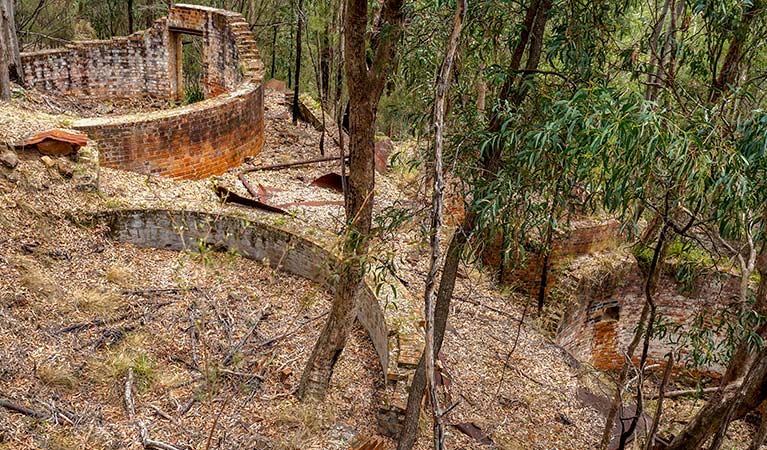
Pitch a tent at one of Wollemi's great campgrounds, like the secluded Colo Meroo backpack campground, the car-accessible Coorongooba campground or the dramatically-situated, car-accessible Newnes campground. With your base set up, you're free to get out and enjoy the park's fantastic outdoor attractions, be they more relaxed pursuits such as picnicking, canoeing and swimming or something more adventurous like rock climbing, horseriding and hiking.
Nature's haven
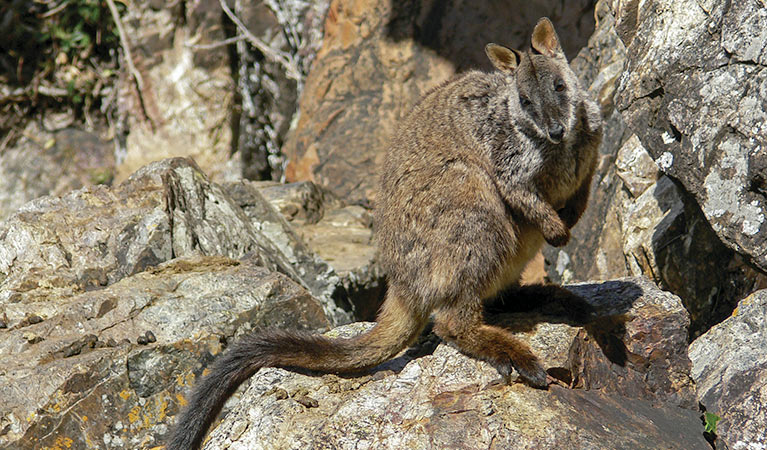
It's little surprise that Wollemi's spectacular landscape shelters a rich diversity of plants and animals. The rare Wollemi pine - a 'living fossil' whose closest relatives thrived some 90 million years ago was rediscovered here in 1994, and the park protects an incredible array of botanical species and communities, from open eucalypt forest and woodlands including Hawkesbury and grey box, to rainforests and perched swamps. This variety makes it an appealing habitat for eastern grey kangaroos, red-necked wallabies and the elusive brush-tailed rock wallaby, as well as the beautifully marked broad-headed snake, regent honeyeater and glossy black cockatoo. Around 55 species of butterfly have also been recorded.
- Glow Worm Tunnel via Wolgan Valley loop Set aside a day to hike 9km through Wollemi National Park on Glow Worm Tunnel via Wolgan Valley loop. Marvel at the historic railway tunnel, a lush rainforest gorge, and rocky pagoda outcrops, on this special walk between Newnes and Lithgow.
- Wollemi guided Glow Worm Tunnel walk Join Wolgan Valley Eco Tours on the popular Glow Worm Tunnel walking track in Wollemi National Park and see the magical natural light show created by thousands of glow worms.
Geological marvels
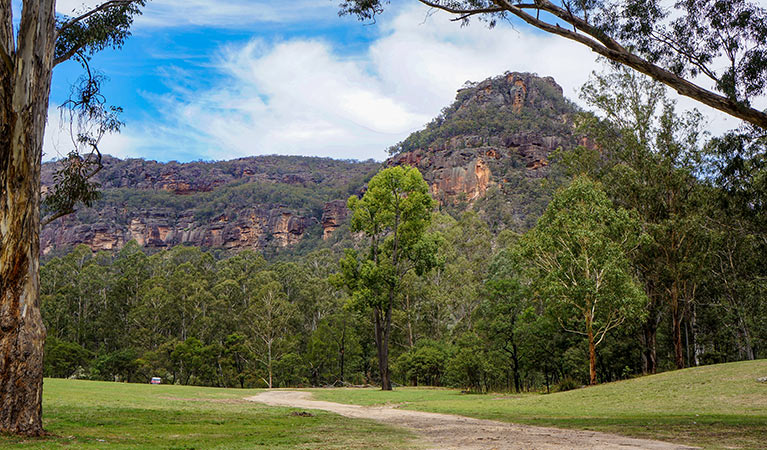
Wollemi's landscape has been sculpted over millennia into a magnificent network of soaring sandstone escarpments, plunging gorges and canyons, winding river valleys and awe-inspiring geological and geomorphological features such as pagoda rock formations, basalt-capped mountains and diatremes. The spectacular Colo gorge and its tributaries form the most extensive sandstone canyon system in eastern Australia. Grab your camera and discover for yourself the breathtaking vistas and natural marvels that make this a World Heritage treasure.
- Explore Wollemi's wonders guided tour Experience the highlights of Wollemi National Park on this guided tour with Hikeandseek NSW. Traverse canyons, tunnels and valleys while learning about the area’s history.
- Guided kayak tours of Ganguddy-Dunns Swamp Experience the natural beauty of escarpments, gorges and wildlife on a guided paddling tour of Gunguddy-Dunns Swamp with Southern Cross Kayaking.
- Pagoda Lookout walking track Pagoda Lookout walking track is a short but steep walk near Rylstone in Wollemi National Park. Enjoy incredible views over ancient pagoda rock formations and the Cudgegong River.
- Wollemi camping and canyoning expeditions Join Roam Adventures and Training on a camping and canyoning adventure in the stunning Wollemi National Park.
Ancient connections
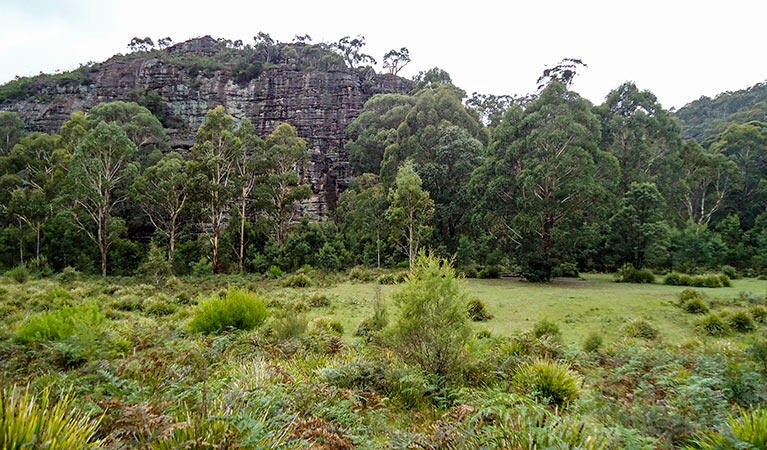
The area that is now Wollemi National Park has held significance to Aboriginal people for at least 12,000 years. Evidence of this connection can be seen throughout the park, including ceremonial grounds, stone arrangements, grinding grooves, scarred trees and rock engravings. There are around 120 known Aboriginal sites in the park and probably many more yet to be discovered. The Wiradjuri, Dharug, Wanaruah and Darkinjung people have a strong and ongoing cultural association with their traditional lands and waters.
- Guided kayak tours of Ganguddy-Dunns Swamp Experience the natural beauty of escarpments, gorges and wildlife on a guided paddling tour of Gunguddy-Dunns Swamp with Southern Cross Kayaking.
- Pagoda Lookout walking track Pagoda Lookout walking track is a short but steep walk near Rylstone in Wollemi National Park. Enjoy incredible views over ancient pagoda rock formations and the Cudgegong River.
Plants and animals protected in this park
Animals
-

Superb lyrebird (Menura novaehollandiae)
With a complex mimicking call and an elaborate courtship dance to match, the superb lyrebird is one of the most spectacular Australian animals. A bird watching must-see, the superb lyrebird can be found in rainforests and wet woodlands across eastern NSW and Victoria.
-

Bare-nosed wombat (Vombatus ursinus)
A large, squat marsupial, the Australian bare-nosed wombat is a burrowing mammal found in coastal forests and mountain ranges across NSW and Victoria. The only other remaining species of wombat in NSW, the endangered southern hairy-nosed wombat, was considered extinct until relatively recently.
-

Southern boobook (Ninox novaeseelandiae)
The southern boobook, also known as the mopoke, is the smallest and most common native owl in Australia. With a musical 'boo-book' call that echoes through forests and woodlands, the southern boobook is a great one to look out for while bird watching.
-

Satin bowerbird (Ptilonorhynchus violaceus)
With vibrant blue-violet eyes and curious antics, the satin bowerbird is a favourite for bird watching and easy to spot as it forages for food in open forest. Relatively common across eastern Australia, in NSW they’re found in coastal rainforests and adjacent woodlands and mountain ranges.
-

Spotted-tailed quoll (Dasyurus maculatus)
The spotted-tailed quoll is the largest remaining carnivorous marsupial on the Australian mainland. It’s protected as a vulnerable species in NSW.
Plants
-

Smooth-barked apple (Angophora costata)
Smooth-barked apple gums, also known as Sydney red gum or rusty gum trees, are Australian native plants found along the NSW coast, and in the Sydney basin and parts of Queensland. Growing to heights of 15-30m, the russet-coloured angophoras shed their bark in spring to reveal spectacular new salmon-coloured bark.
-

Wollemi pine (Wollemia nobilis)
The Wollemi pine is one of the world’s oldest and rarest trees. Only 46 adult trees and 43 juveniles remain in the wild. Belonging to a 200 million year-old plant family, this critically endangered Australian species is considered a global treasure.
Environments in this park
Education resources (1)
What we're doing
Wollemi National Park has management strategies in place to protect and conserve the values of this park. View the detailed park and fire management documents. Here is just some of the work we’re doing to conserve these values:
Managing weeds, pest animals and other threats
Pests and weeds have a significant impact to the ecosystems within Wollemi National Park. NPWS carries out risk assesments for new and emerging weeds as well as fox control to protect biodiversity in this park. Remote area weeding is carried out by some extremely dedicated volunteers.
Exploring World Heritage
Part of the Greater Blue Mountains Area World Heritage Property, the spectacular landscapes of Wollemi National Park are carefully protected and preserved through a range of NPWS strategies. Educational initiatives and long-term conservation projects are in place in this park. NPWS welcomes community input and works to identify, protect, conserve, present, transmit to future generations and, where necessary, rehabilitate the park’s World Heritage values.
Developing visitor facilities and experiences
NPWS works to promote positive experience in NSW national parks. To ensure optimal safety, comfort and enjoyment for visitors, the tracks and trails in Wollemi National Park are regularly maintained, upgraded or developed as required.
Managing fire
NSW is one of the most bushfire prone areas in the world as a result of our climate, weather systems, vegetation and the rugged terrain. NPWS is committed to maintaining natural and cultural heritage values and minimising the likelihood and impact of bushfires via a strategic program of fire research, fire planning, hazard reduction, highly trained rapid response firefighting crews and community alerts.
General enquiries
- National Parks Contact Centre
- 7am to 7pm daily
- 1300 072 757 (13000 PARKS) for the cost of a local call within Australia excluding mobiles
- parks.info@environment.nsw.gov.au
Contact
- in the Sydney and surrounds, North Coast and Country NSW regions
Wollemi National Park is always open but may have to close at times due to poor weather or fire danger.
-
-
Blue Mountains Heritage Centre and Blackheath office
02 4787 8877
Contact hours: 9am to 4.30pm daily. Closed Christmas Day. - 270 Govetts Leap Road, Blackheath NSW 2785
-
Email: bluemountains.heritagecentre@environment.nsw.gov.au
-
Blue Mountains Heritage Centre and Blackheath office
-
-
Mudgee office
02 6370 9000
Contact hours: Monday to Friday, 9am to 4:30pm. - 27 Inglis Street, Mudgee NSW 2850
-
Email: npws.mudgee@environment.nsw.gov.au
-
Mudgee office
-
-
Bulga office
02 6574 5555
Contact hours: Monday to Friday, 9.30am to 4pm. - 2156 Putty Road, Bulga NSW 2330
-
Email: npws.wollemiyengo@environment.nsw.gov.au
-
Bulga office
In this park:
Things to do (21)
- Aboriginal culture (1)
- Adventure sports (2)
- Birdwatching and wildlife encounters (1)
- Canoeing/paddling (2)
- Cultural heritage (1)
- Environmental appreciation/study (1)
- Historic heritage (4)
- Picnics and barbecues (1)
- Road trips and car/bus tours (1)
- Sightseeing (4)
- Swimming (1)
- Walking (8)
- Waterfalls (1)

